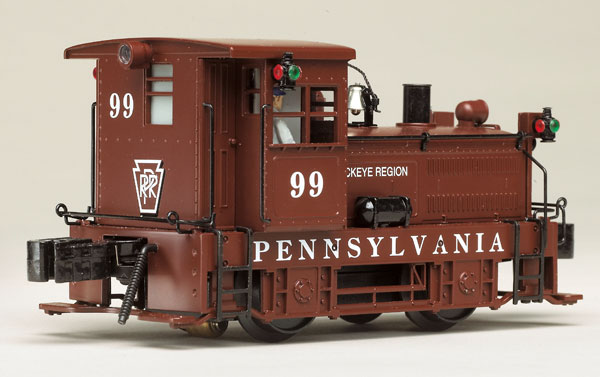Industrial switchers are usually operated by firms with less demanding tonnage requirements than a regular railroad, notably large factories, grain elevators, and gravel pits. In the postwar era there were several players selling small industrial locomotives to replace aging fleets of second- and third-hand 0-4-0s and 0-6-0s. While the giant locomotive builders often cataloged smaller prime movers for odd jobs, industrial switchers were really in the realm of smaller outfits.
Firms like the Davenport Co. of Davenport, Iowa; H. K. Porter of Pittsburgh, Pa.; Whitcomb of Rochelle, Ill.; and Plymouth Locomotive Works of Plymouth, Ohio, served this market.
The model
In the modern O gauge world, there’s a product void when it comes to these small industrial switchers. About as close as we’ve come have been models like the K-Line Alco S-2 or the oversized GE 44-tonners offered by Lionel and Williams. K-Line is now putting the industrial switcher on the map with its model of a Plymouth switcher, which we gauge to be a model of a 10- or 20-ton engine.
The first thing you’ll notice when you take this model out of the box is the heft. Heft? Yes, heft. The 41/4-inch-long shell (17 feet in O scale) and frame are made of die-cast metal.
The locomotive weighs 1 pound, 4 ounces. While I’d bet that the power unit beneath this rig is similar to the one propelling the K-Line Coca-Cola Polar Bear handcar, the Plymouth’s extra weight is welcome.
This diminutive switcher is big on details, including vents for the motor, a smokestack, a bell (with lanyard), and four illuminated marker lights (red fore and aft, green to the sides). This also may be the only locomotive I’ve seen priced at under $100 that has simulated uncoupler arms!
Speaking of couplers, the model comes with die-cast metal dummy couplers installed, but poke around the box and you’ll find two metal operating couplers ready to be installed.
The operating couplers, however, stick out noticeably farther than the dummy couplers to allow the “thumbtacks” below to clear the edge of the locomotive frame. The Plymouth is cataloged in several road names – Pennsylvania, Milwaukee Road, Union Pacific, Peabody Coal, New Hope Valley, and a special Baltimore & Ohio edition as a fundraiser for the B&O Museum.
On the test track
While this Plymouth certainly doesn’t have a Hemi engine under the hood, I was still smiling after I finished its performance testing. The low-end speed average was 6.2 scale mph, and the high-end speed average was 50 scale mph. As far as grunt goes, this model averaged a tiny .02 ounces of drawbar pull.
So what does that number really mean? We put the K-Line switcher on one of our home layouts, and it could pull as many as six modern-era (Atlas O and K-Line) refrigerator cars before its wheels began slipping.
This is okay. In the real world, no one ever put a Plymouth on a 100-car coal train.
Inside, the Plymouth sports a pair of pickup rollers 21/4 inches apart and a switch to lock out the reverse unit. The K-Line model also comes with a bottle of smoke fluid.
Yes, this baby has a smoke unit. You’ll get an output worthy of a small gasoline motor or a smallish diesel prime mover. A smoke on/off switch is mounted on the frame.
While many of today’s locomotives are equipped with command control and sound systems, the tiny Plymouth is too small; there’s no horn either.
The K-Line Plymouth is a neat little locomotive that meets my expectations for a small switcher and exceeds my expectations for fun.















I have several of these little switchers. They are well constructed and very close the to the prototype which I photographed at the Strasburg Railroad in Strasburg, Pennsylvania. They have a real operating locomotive. The Strasburg Railroad model by K-Line is very close the the real thing. The locomotive (all of them) looks great on my layout. It will handle three or four lightweight cars easily.
I have one of these little guys on a small mining loop in the mountains of my layout and it's well worth the money. It has great smoke output, runs very smoothly, and it has directional headlights! My version has springs in the scale couplers, and if you give the loco a little abrupt jerk in reverse, you can release the coupler (I'm not sure if it was designed to do that or not.) Coupling back up is easy. You can find these guys now (2008) with 6 ore cars for around $80, IT'S A STEAL!!!
got to get one of these cute
I want one!
One more thing that this little guy has; a GREAT paint job. No runs, no smears, no overspray. I have one painted/lettered for Coca-Cola and what Bob and all the other owners of this little gem say are absolutely right on target. After seeing this little guy and running it you would think you should have paid more than 100.00 for it. It is real nice to see lower-priced models with high-end paint and features.
Great Engine, I need one,
A few years ago I got ahold of the Reading Railroad Plymouth coal train with the six coal cars. I couldn't believe the quality for the price. (I got it from Trainworld in NYC—they do take care of their customers!)
This little switcher is not only a good-looker, it's a great runner. Well worth the investment to just get away from all the high-tech and expensive locos that require all the stupid batteries to run right. (But all this battery operated crap is another topic that needs to be addressed anyway).
I have the Kennecott Copper edition of the Plymouth with 6 ore cars. I ran it on a dogbone of SuperStreets track at Christmas – one end of the track went into the simulated mine under the Christmas Tree. I pulled the coal load from two cars and put in Christmas packages.